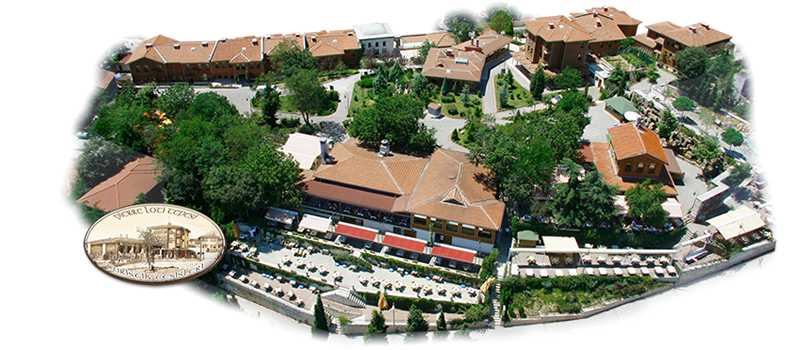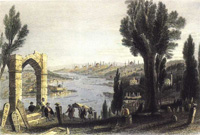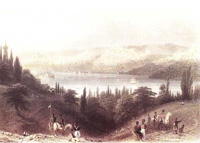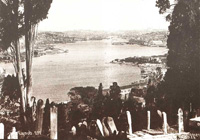EYÜP AND PIERRE LOTI HILL
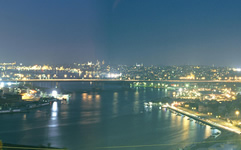 The locality named as “Eyüp Sultan” today, was called “Kozmiyon” in Byzantine period. There were a wooden circus, fountains, chateaus, a caravansary, and four qualified churches in Kozmiyon, mentioned with the fine weather and the variety of prey animals. Unfortunately, none of these monuments couldn’t reach the present day due to many invasions of Bulgarians to Constantinople and the raids, loots and fires that came out during the Crusade on April 13,1204.
The locality named as “Eyüp Sultan” today, was called “Kozmiyon” in Byzantine period. There were a wooden circus, fountains, chateaus, a caravansary, and four qualified churches in Kozmiyon, mentioned with the fine weather and the variety of prey animals. Unfortunately, none of these monuments couldn’t reach the present day due to many invasions of Bulgarians to Constantinople and the raids, loots and fires that came out during the Crusade on April 13,1204.
Eyüp ,one of the biggest counties of Istanbul beginning from the Edirnekapı City Walls and extends over Black Sea coast , is one of the first Ottoman settlements found right after the conquest of Constantinople. i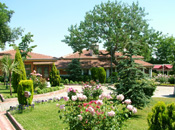 Eyüp, constituting one of the most amazing cultural centers of Ottoman and having the best, most charming period in “Tulip Age”, has the characteristics of an outdoor-museum with its historical tombs, mosques, and the cafe that named with Pierre Loti, the French writer.
Eyüp, constituting one of the most amazing cultural centers of Ottoman and having the best, most charming period in “Tulip Age”, has the characteristics of an outdoor-museum with its historical tombs, mosques, and the cafe that named with Pierre Loti, the French writer.
Let’s start our tour in Eyup, located out of the city walls and in the south shore of Golden Horn,with Eyüp Sultan Külliyesi that consists of the mosque gives its name to the county, madrasah, imaret and Turkish bathroom. (Külliye is an Islamic-Ottoman social complex.)The person whose name is given to the Külliye that was found thanks to Mehmet the Conqueror, is Halid Bin Zeyd Ebu Eyyub el-Ensari who is considered worthy to get the title of “mihmandar_ı Resullullah” as he hosted Hz.Mohammed in his house.El-Ensari, who martyrized in 688 while he was the standard bearer against the unsuccessful invasion by Emevis, was buried somewhere in this area but his grave went missing in time.
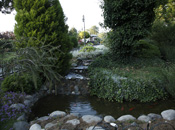 In the following days right after the conquest of Istanbul, building a tomb on the basis of a dream,that showed the place of el-Ensari’s grave, had by Akşemseddin,who was the sheik of Bayrami Sect (Mehmet the Conqueror was connected to this sect too) was the first step to the foundation of Eyüp.The tomb named “Hazret-i Halid” in Ottoman Age and now called “Eyüp Sultan” has always been one of the most important tombs visited by Muslims. The tomb, where people pray, make vows, and visit for important incidents such as birth, circumcision, marriage and death, also became the focus of interest for the high state officials as the ceremony of Ottoman Emperors to gird themselves with sword took place here .It didn’t take a long time for Eyüp to be formed as an allocation unit ,in concurrence with the mosque, madrasah, Turkish bathroom and imaret built up around the tomb became on of the most important külliyes in Istanbul. Another feature of the mosque, assumed to have built in1459, is being the first “selatin mosque”.In other words it is the first mosque which was built for a Sultan. The mosque, was added new portios and renovated by various Ottoman emperors , was greately restored after the earthquake in 1766 and really approached to classic Ottoman architecture.
In the following days right after the conquest of Istanbul, building a tomb on the basis of a dream,that showed the place of el-Ensari’s grave, had by Akşemseddin,who was the sheik of Bayrami Sect (Mehmet the Conqueror was connected to this sect too) was the first step to the foundation of Eyüp.The tomb named “Hazret-i Halid” in Ottoman Age and now called “Eyüp Sultan” has always been one of the most important tombs visited by Muslims. The tomb, where people pray, make vows, and visit for important incidents such as birth, circumcision, marriage and death, also became the focus of interest for the high state officials as the ceremony of Ottoman Emperors to gird themselves with sword took place here .It didn’t take a long time for Eyüp to be formed as an allocation unit ,in concurrence with the mosque, madrasah, Turkish bathroom and imaret built up around the tomb became on of the most important külliyes in Istanbul. Another feature of the mosque, assumed to have built in1459, is being the first “selatin mosque”.In other words it is the first mosque which was built for a Sultan. The mosque, was added new portios and renovated by various Ottoman emperors , was greately restored after the earthquake in 1766 and really approached to classic Ottoman architecture.
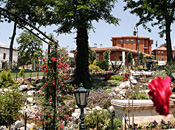 Another famous unit of Eyüp, that turns into a spiritual center by this way is cemeteries. The people who visited the tomb to supplicate while they were living also wished to be buried next to Eyüp Sultan when they die. Eyüp cemetery, besides ordinary people many famous ones were buried, has been the everlasting resting place for many well-known personalities from sultans to grand viziers, from shayk al-islams to viziers, from commandants to religious and sufic scholars both in Ottoman and republic ages. The inscriptions on the gravestones of this cemetery leaning from the coasts of Golden Horn to Edirnekapı city walls, have been very important historical documents of that period. For example,Devlet Han’s ( Gazi Gray II’s son) grave was assumed to be in Kırım, Bahçesaray but later on , the grave stone was excavated in Eyüp. Interior ornamentation and china are used in the plan styles that are mostly made of marble and carried out with Ottoman Tomb Architecture.One of the most interesting units of the cemetery is the part segregated for the graves of hangmen.In Ottoman age, there weren’t any gravestones giving information about those hangmen, instead there were cubic gravestones for them.Historians are on a collision course with this cemetery of hangmen. A group of historians think, the cemetery is near-by Ayvansaray City Walls through Eyüp; acoording to the others it’s near-by the teleferic stop used by the teleferic operating from Eyup to Pierre Loti Hill.
Another famous unit of Eyüp, that turns into a spiritual center by this way is cemeteries. The people who visited the tomb to supplicate while they were living also wished to be buried next to Eyüp Sultan when they die. Eyüp cemetery, besides ordinary people many famous ones were buried, has been the everlasting resting place for many well-known personalities from sultans to grand viziers, from shayk al-islams to viziers, from commandants to religious and sufic scholars both in Ottoman and republic ages. The inscriptions on the gravestones of this cemetery leaning from the coasts of Golden Horn to Edirnekapı city walls, have been very important historical documents of that period. For example,Devlet Han’s ( Gazi Gray II’s son) grave was assumed to be in Kırım, Bahçesaray but later on , the grave stone was excavated in Eyüp. Interior ornamentation and china are used in the plan styles that are mostly made of marble and carried out with Ottoman Tomb Architecture.One of the most interesting units of the cemetery is the part segregated for the graves of hangmen.In Ottoman age, there weren’t any gravestones giving information about those hangmen, instead there were cubic gravestones for them.Historians are on a collision course with this cemetery of hangmen. A group of historians think, the cemetery is near-by Ayvansaray City Walls through Eyüp; acoording to the others it’s near-by the teleferic stop used by the teleferic operating from Eyup to Pierre Loti Hill.
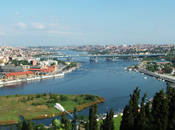 We started our tour with the blessed spaces in the center of Eyüp.Now it’s time to have a look at the ridges where the famous Golden Horn view can be seen best.The region entitled with the name of famous French writer Pierre Loti, who lived in Istanbul for long years and really loved Istanbul, is the best choice to watch this great view.It is said that Loti, who considered Turkey as his second motherland ,used to come to this café called “Rabia Kadın Kahvesi” and write his novel “Aziyade” having the view of Golden Horn. This zone, keeps this place which is transformed to a typical Turkish cafe,is called “İdris Köşkü Mesiresi” in Evliya Çelebi’s travel book “Seyahatname”.Double-epigraphed, wooden “Kaşgari Tekkesi” ,dated 1813 and located on the way from the tourist facility to Eyüp Mosque, is one of these structures.Another important Persian-epigraphed building,at the right corner of the service area and located at a trivium,is “Çolak Şeyh Hasan Türbesi.”A part of this building is .çilehane(çilehane is a place in which a dervish undergoes and suffers to strength his patience.)and Çolak Hasan Dede’s grave is here too.The historical building, on the same way with “Çolak Şeyh Hasan Tekkesi”,is “Sıbyan Mektebi” or a nursery school in today’s context.(Today, that school is used as a prayer room that belongs to the service area.)The grave of a whirling dervish called “Iskender Dede”, passed away in 1589,takes place in Pierre Loti Tourist Facility located forefront Sıbyan Mektebi that was built by Ottoman history writer İdris-i Bitlisi. One of the two water wells infront of Iskender Dede is the famous “Dilek Kuyusu” (a water well for wishes)Evliya Çelebi writes about this water well in his Seyahatname and says: the people who look in to the well,can see their own wishes they keep in their hearts. There is also a drinking fountain next to the frontage of Sıbyan Mektebi.It’s been known that this drink fountain,constructed by İdris_i Bitlisi,had been devastated and as it was rebuilt by Rayet Keşan Kalfa(one of SultanAbdülaziz’s maids) it got that name.
We started our tour with the blessed spaces in the center of Eyüp.Now it’s time to have a look at the ridges where the famous Golden Horn view can be seen best.The region entitled with the name of famous French writer Pierre Loti, who lived in Istanbul for long years and really loved Istanbul, is the best choice to watch this great view.It is said that Loti, who considered Turkey as his second motherland ,used to come to this café called “Rabia Kadın Kahvesi” and write his novel “Aziyade” having the view of Golden Horn. This zone, keeps this place which is transformed to a typical Turkish cafe,is called “İdris Köşkü Mesiresi” in Evliya Çelebi’s travel book “Seyahatname”.Double-epigraphed, wooden “Kaşgari Tekkesi” ,dated 1813 and located on the way from the tourist facility to Eyüp Mosque, is one of these structures.Another important Persian-epigraphed building,at the right corner of the service area and located at a trivium,is “Çolak Şeyh Hasan Türbesi.”A part of this building is .çilehane(çilehane is a place in which a dervish undergoes and suffers to strength his patience.)and Çolak Hasan Dede’s grave is here too.The historical building, on the same way with “Çolak Şeyh Hasan Tekkesi”,is “Sıbyan Mektebi” or a nursery school in today’s context.(Today, that school is used as a prayer room that belongs to the service area.)The grave of a whirling dervish called “Iskender Dede”, passed away in 1589,takes place in Pierre Loti Tourist Facility located forefront Sıbyan Mektebi that was built by Ottoman history writer İdris-i Bitlisi. One of the two water wells infront of Iskender Dede is the famous “Dilek Kuyusu” (a water well for wishes)Evliya Çelebi writes about this water well in his Seyahatname and says: the people who look in to the well,can see their own wishes they keep in their hearts. There is also a drinking fountain next to the frontage of Sıbyan Mektebi.It’s been known that this drink fountain,constructed by İdris_i Bitlisi,had been devastated and as it was rebuilt by Rayet Keşan Kalfa(one of SultanAbdülaziz’s maids) it got that name.
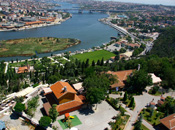 Historical artifacts aren’t limited with these .There is also a cistem, made in Byzantine era and operatively used in Ottoman Period, under the field that constitutes the center of garden in tourist facility. On this hill, named as “Karyağdı Tepesi” throughout history, the public was benefited from great fresh water by transmitting this water ,which came after snow-melting, to the taps/drink fountains. Today there is no trace about a namazgah(an open-air place allocated to pray) that was between Sıbyan Mektebi and Iskender Dede’s grave in those days.In addition, Karyağdı Baba Dervish Convent takes place in the upper parts of facility with the form of a ruin. And in the garden of this facility there are four graves belonging to Ali Ağa,atçıbaşı of his period, and his family.( atçıbaşı was the person who was in charge of all horses belonged to the palace)
Historical artifacts aren’t limited with these .There is also a cistem, made in Byzantine era and operatively used in Ottoman Period, under the field that constitutes the center of garden in tourist facility. On this hill, named as “Karyağdı Tepesi” throughout history, the public was benefited from great fresh water by transmitting this water ,which came after snow-melting, to the taps/drink fountains. Today there is no trace about a namazgah(an open-air place allocated to pray) that was between Sıbyan Mektebi and Iskender Dede’s grave in those days.In addition, Karyağdı Baba Dervish Convent takes place in the upper parts of facility with the form of a ruin. And in the garden of this facility there are four graves belonging to Ali Ağa,atçıbaşı of his period, and his family.( atçıbaşı was the person who was in charge of all horses belonged to the palace)
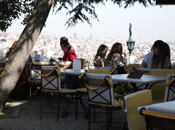 Pierre Loti and historical structures around it, are publicized by Istanbul Metropolitan Municipality in accordance with “approved projects of Cultural and Natural Heritage Preservation Board” and turned into a tourist facility with Turquhouse Boutique Hotel including seven mansion and totally 67 rooms, Tarihi Kahve, Yeşil Cafe, Nargile Evi(nargileh house), Aziyade Restaurant and open air zones.
Pierre Loti and historical structures around it, are publicized by Istanbul Metropolitan Municipality in accordance with “approved projects of Cultural and Natural Heritage Preservation Board” and turned into a tourist facility with Turquhouse Boutique Hotel including seven mansion and totally 67 rooms, Tarihi Kahve, Yeşil Cafe, Nargile Evi(nargileh house), Aziyade Restaurant and open air zones.

